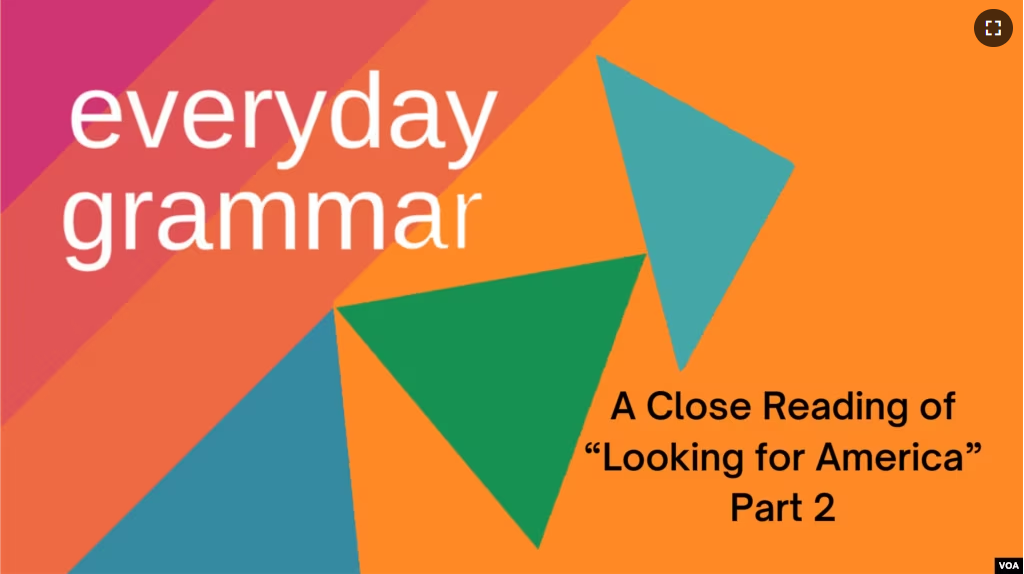In today’s Everyday Grammar, we finish our discussion of the 2019 song, Looking for America, by singer Lana Del Rey. By making a close reading of the song’s words, we will understand more about its sounds and structure.
What is a close reading?
A close reading is a deep reading of a story. Works of literature such as poems are often the object of close readings. These can include the words to songs. The aim is to understand the writer’s intentions by looking closely at the details. Last time, we considered the grammar and cultural elements of the song. This time we will talk about the poetic devices and the syllable structure of a few lines.
Del Rey uses many poetic devices to strengthen what may be thought of as a simple song. Let’s take a look.
Looking for America
I flew back to New York City
Missed that Hudson River line
Took a train up to Lake Placid
That’s another place and time, where
I used to go to drive-ins and listen to the blues
So many things that I think twice about before I do, no
I’m still looking for my own version of America
One without the gun, where the flag can freely fly
No bombs in the sky, only fireworks when you and I collide
It’s just a dream I had in mind
Syllable Structure
In lines one and three, Del Rey uses the same number of syllables, eight in total.
I flew back to New York City
Took a train up to Lake Placid
Then in lines two and four, she uses seven syllables.
Missed that Hudson River line
That’s another place and time, (where)
The relative pronoun “where” ends the fourth line as it is written. This extra syllable does match the structure, but as Lana sings, she adds the word “where” to the beginning of the next line, so we can count it with line five.
Now with the added word of “where,” lines five and six have fourteen syllables each. Line six just has an added word of “no.” This addition might have been Del Rey ad-libbing or speaking spontaneously without planning.
(Where) I used to go to drive-ins and listen to the blues
So many things that I think twice about before I do, (no)
Let’s move onto other poetic devices.

Rhymes and alliteration
Rhymes are made with two or more words that end in the same sound. Lines two and four share a similar vowel sound, /ai/, with the words “line” and “time.” Although they do not end in the same consonant sound, they still rhyme. This rhyming of similar vowel sounds is called assonance.
Missed that Hudson River line…
That’s another place and time…
We see in lines five and six two other rhymes created by using the vowel sound /u/ with the words “blues” and “do.”
I used to go to drive-ins and listen to the blues
So many things that I think twice about before I do…
Lastly, in lines eight, nine and ten, Del Rey uses other poetic devices.
One without the gun, where the flag can freely fly
No bombs in the sky, only fireworks when you and I collide
It’s just a dream I had in mind
In line 8, we see another form of rhyme with the words “one” and “gun.” This is internal rhyme. It is when a writer includes rhyming words within the same line, rather than at the end.
We also see in line 8 repeating “f” sounds with the words “…flag can freely fly.” This is an example of alliteration, repetition of the first consonant sounds in words that are close together.
In line 9, we have more assonance with the /ai/ vowel with the words “sky,” “fireworks,” and “collide.” In all three lines, the repetition of the /ai/ vowel is seen throughout with “fly,” “collide,” and “mind,” mirroring the sounds in the beginning with “line” and “time.”
Final Thoughts
In today’s Everyday Grammar, we found more details in Lana Del Rey’s song Looking for America. We considered syllable structure and learned about several poetic devices such as assonance, internal rhyme and alliteration.
I’m Faith Pirlo.
Faith Pirlo wrote this lesson for VOA Learning English.
______________________________
Words in This Story
intention – n. the thing that you plan to do or achieve
drive-ins – n. places where people watch movies in their cars
blues – n. musical form created by African Americans in the Southern United States
collide – v. the action of two (or more) objects crashing into each other
spontaneously – adv. done or said in a natural and often sudden way and without a lot of thought or planning
rhyme – n. two or more words that end in the same sound
vowel – n. a speech sound made with your mouth open and your tongue in the middle of your mouth not touching your teeth, lips
consonants – n. a speech sound (such as /p/, /d/, or /s/) that is made by partly or completely stopping the flow of air breathed out from the mouth
internal – adj. existing or taking place inside something
repetition – n. the action of repeating something
mirroring – n. the act of being very similar to something
